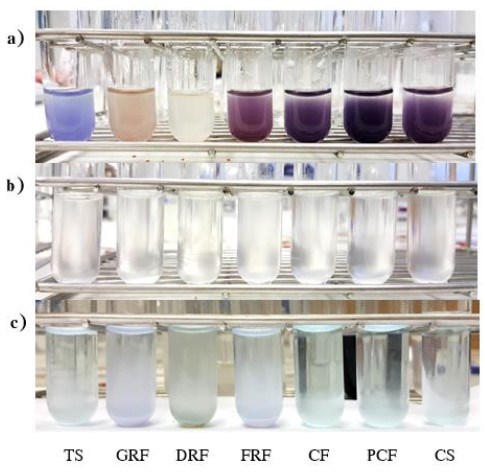การประเมินแป้งต่างชนิดที่เป็นสารช่วยยึดเกาะ และคุณสมบัติของยาหอมเทพจิตรในรูปแบบยาเม็ด
คำสำคัญ:
'ยาหอมเทพจิตร', 'ยาเม็ด', 'สารช่วยยึดเกาะ 'บทคัดย่อ
ต ารับยาหอมเทพจิตรเป็นยาแผนไทยที่อยู่ในบัญชียาหลักแห่งชาติ(NLEM)ซึ่งเป็นยาผงต้องชงกับน ้าร้อน การพัฒนาให้อยู่ในรูปแบบยาเม็ดมักจะเกิดปัญหาเกี่ยวกับการไหลของผงยาในการตอกโดยตรงดังนั้นการเตรียมยาในรูปแบบของแข็งจะนิยมใช้เทคนิคการเตรียมแบบแกรนูลงานวิจัยนี้มีวัตถุประสงค์ในการประเมินแป้งชนิดต่างๆที่ใช้เป็นสารช่วยยึดเกาะของยาหอมเทพจิตรในรูปแบบยาเม็ดโดยใช้เทคนิคการเตรียมแกรนูลเปียกโดยศึกษาสมบัติทางกายภาพของผงยาหอมเทพจิตร ได้แก่ การไหล,ความหนาแน่นรวม,ความหนาแน่นจาเพาะที่ถูกกด,ความสามารถในการตอกอัด,Hausner ratio, ความสม ่าเสมอของการผสม,การละลาย,ปริมาณความชื้น เป็นต้น รวมถึงทดสอบฤทธิ์ต้านอนุมูลอิสระของต ารับด้วยวิธี DPPH, ABTS และ FRAPเมื่อแบ่งการสกัดเป็น 3 วิธี คือการชงด้วยน ้าร้อน, การหมักด้วย 95% เอทานอลและการกระจายตัวในน ้ากระสายยา(ดอกไม้เทศ)ประเมินคุณภาพเม็ดยาตามมาตรฐานUSP 40 ได้แก่ความเบี่ยงเบนของน ้าหนักเม็ดยา,ความแข็ง,ความหนา,เส้นผ่านศูนย์กลาง,ความกร่อนและเวลาที่ใช้ในการแตกตัวเมื่อใช้สารยึดเกาะ7 ชนิด คือแป้งมัน,แป้งข้าวเหนียว,แป้งข้าวไรย์สีด า,แป้งข้าวเจ้าโม่น ้าชนิดพิเศษ,แป้งข้าวโพดชนิดCorn flour,Pure corn flour และ Cone starchจากการศึกษาพบว่า ผงยาหอมเทพจิตรมีค่าการไหลต่าความชื้นค่อนข้างสูงเนื่องจากประกอบด้วยสมุนไพรที่เป็นไฟเบอร์และน้ามันหอมระเหยท าให้ผงยามีความฟูและชื้น การตอกโดยตรงเป็นไปได้ยากต้องเตรียมในรูปแบบแกรนูลเปียกสารสกัด 95% เอทานอลของต ารับสามารถต้านอนุมูลอิสระสูงที่สุดทั้งวิธี DPPH (IC50= 27.95± 4.78g/ml), ABTS (VEAC= 0.42 ± 0.01mM/gและ TEAC= 0.28 ± 0.01mM/g)และ FRAP (FRAP value= 0.72 ± 0.01mM/g)จากการประเมินคุณภาพยาเม็ด พบว่า แป้งข้าวโพดชนิดCone starchเป็นสารยึดเกาะที่มีประสิทธิภาพดีที่สุดโดยมีความแข็งสูง(2.82 ± 0.07 kp) ความกร่อนต ่า (0.0550 ± 0.02 %) และการแตกตัวดี (17.91 ± 0.12 min)ในขณะที่แป้งข้าวโพดชนิดPure corn flourและ Corn flourมีประสิทธิภาพรองลงมา ตามล าดับขณะเดียวกันแป้งข้าวโพดชนิดPure corn flourให้ค่าความกร่อน (0.0081 ± 0.00 %) ดีกว่าแป้งข้าวโพดชนิดCorn flourจึงเป็นอีกทางเลือกหนึ่งของสารช่วยยึดเกาะที่สามารถทดแทนการใช้แป้งข้าวโพดชนิด Corn flourสาหรับตารับยาหอมเทพจิตรชนิดเม็ดเนื่องจากมีคุณภาพของเม็ดยาที่ได้ใกล้เคียงกันและให้ค่าความกร่อนที่ต่ากว่า
เอกสารอ้างอิง
Benzie, I. F., & Strain, J. J. (1996). The ferric reducing ability of plasma (FRAP) as a measure of “antioxidant power”: the FRAP assay. Analytical biochemistry, 239(1),70-76.
Boonwatcharapan, Y., Sutthiparinyanont, S. and Chitropas, P. (2012).A Feasibility Study of Alcoholic-Alkaline Treated Rice Starch for Disintegrant in Tablet. KKU Res J (GS), 13(3),68-77.
Channarong, S., Jutiviboonsuk, A., & Korsanan, S. (2012). Total reducing antioxidant capacity of Thai herbal aromatic powder (Ya-Hom) measured by FRAP Assay. Thai Pharmaceutical and Health Science Journal, 7(3),111-114.
Chootip, K., Chaiyakunapruk, N., Soonthornchareonnon, N., Scholfield, C. N., & Fuangchan, A. (2017). Efficacy and safety of “Yahom” as a traditional Thai herbal therapy: a systematic review. Journal of ethnopharmacology, 196, 110-123. http://dx.doi.org/10.1016/j.jep.2016.12.002
Defloor, I., Dehing, I., & Delcour, J. A. (1998). Physico‐chemical properties of cassava starch. Starch‐Stärke, 50(2‐3), 58-64.
Furukawa, S., Tanaka, K., Masumura, T., Ogihara, Y., Kiyokawa, Y., & Wakai, Y. (2006). Influence of rice proteins on eating quality of cooked rice and on aroma and flavor of sake. Cereal chemistry, 83(4), 439-446.
Jariyapongskul, A., Pathumraj, S., & Niimi, H. (2006). Effects of Yahom on the regional cerebral blood flow in rat using fluorescence videomicroscopy.Clinical hemorheology and microcirculation, 34(1-2), 139-144.
Kaewmaneechai, A.(2011). “Starch” and“Flour”. 3M Food Safety, 26(1), 1-3.
Khotnawang, S. (2010). The Russian black bread and the Russians since the past to the present (C. 9-21)[Bachelor’s thesis]. Thammasat University. (in Thai)
Kim, C. H., Hwang, B. S., Hwang, Y., Oh, Y. T., & Jeong, J. W. (2022). Evaluation of antioxidant and antiinflammatory activity of ethanolic extracts of Polygonum senticosum in lipopolysaccharide-induced RAW 264.7 macrophages. Journal of Laboratory Medicine, 46(1), 51-59.
Laovachirasuwan, P., Srijesdaruk, V., Chitropas, P., Otsuka, M. &Peerapattana, J. (2013).The Study of Modified Glutinous Rice Starch as a Filler-Binder for Direct Compression Tablets. in Proc.The 5thAnnual Northeast Pharmacy Research Conference of 2013 “Pharmacy Profession: Moving Forward to ASEAN Harmonization” Faculty of Pharmaceutical Sciences, Khon Kaen University, Thailand, February 16-17, 2013, pp. 100-103.
Manok, S., & Limcharoen, P. (2015). Investigating antioxidant activity by DPPH, ABTS and FRAP assay and total phenolic compounds of herbal extracts in Ya-Hom Thepphachit. Advanced Science, 15(1), 106-117.
Matangkasombat, O. (1973). Study on the cardiovascular effect of Ya-hom (a Thai folk medicine). Mahidol University Annual Research Abstract, 67.
Monton, C. H. A. O. W. A. L. I. T., Saingam, W. O. R. A. W. A. N., Suksaeree, J., & Sakunpak, A. P. I. R. A. K.(2014). Formulation development and physical properties study of Thai traditional herbal tablets: original Jit-Tra-Rom recipe. Int J Pharm Pharm Sci, 6(4), 611-614.
Muazu, J., Abdulwoliyu, A., & Mohammed, G. T. (2013). Design, formulation and evaluation of bitter leaf tablets. Int. J. Pharm. Sci. Res, 4, 1789-1795.
National Drug System Development Committee. (2012). National List of Essential Medicines (Issue 2) B.E. 2012, dated 21 August 2012, Announced in the Royal Gazette dated 23 January 2013.
Niwat, C. (2019). Effects of infusion conditions on bioactive compounds and antioxidant activities of banaba herbal tea. Asia Pacific Journal of Science and Technology, 24(4), 1-7.
Re, R., Pellegrini, N., Proteggente, A., Pannala, A., Yang, M., & Rice-Evans, C. (1999). Antioxidant activity applying an improved ABTS radical cation decolorization assay. Free radical biology and medicine, 26(9-10), 1231-1237.
Rowe, C.R., Sheskey, P.J. and Weller, P.J. (2003).Handbook of pharmaceutical excipients. 4thed.,London: Pharmaceutical Press.
Rungravi Temsiririrkkul. (2013). How to choose Ya-Hom?. RetrievedAugustfrom URLhttp://www.pharmacy.mahidol.ac.th/thai/knowledgeinfophp ?id=103.
Sriroth, K. &Piyachomkwan, K. (2007). Dough technology. 4thed.,Bangkok: Kasetsart University.
Suvitayavat, W., Kodchawongs, J., Thirawarapan, S. S., & Bunyapraphatsara, N. (2004). Effects of Ya-hom on the gastric secretion in rats. Journal of ethnopharmacology, 94(2-3), 331-338.http://doi:10.1016/j.jep. 2004.06.003
Suvitayavat, W., Tunglert, S., Thirawarapan, S. S., & Bunyapraphatsara, N. (2005). Effects of Ya-hom on blood pressure in rats. Journal of ethnopharmacology, 97(3), 503-508.http://doi:10.1016/j.jep.2004.12.004
Soonthornchareonnon, N., et al. (2011).Research and Development of Medicinal Formulas from Herbs in the National List of Essential Medicines. 1sted., Department of Foreign Trade Ministry of Commerce: Nonthanuri, 75-89.
Swinkels, J. J. M. (1985). Composition and properties of commercial native starches. Starch‐Stärke, 37(1), 1-5.
The United States Pharmacopeial Convention. (2017). The United States Pharmacopeia : USP 40: The National Formulary 33. 1sted. Rockville, Md.: United States Pharmacopeial Convention.

ดาวน์โหลด
เผยแพร่แล้ว
ฉบับ
ประเภทบทความ
หมวดหมู่
สัญญาอนุญาต
ลิขสิทธิ์ (c) 2024 Journal of Applied Science and Emerging Technology

อนุญาตภายใต้เงื่อนไข Creative Commons Attribution-NonCommercial-NoDerivatives 4.0 International License.

